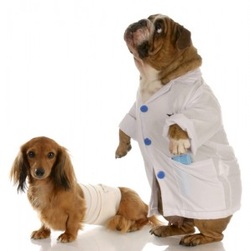You shouldn’t think having your dog undergo knee surgery means you won’t have any control over his recovery. You can control how quickly your dog recovers from knee surgery. Although there are a few dogs that go recover from knee surgery for dog arthritis speedily, almost all will need some physical rehabilitation and exercise support.
Before starting any kind of dog arthritis therapy or exercise routines, mentioned below are primary things you need to know before starting with therapy.
Make Sure the Surgery was Effective
Any kind of surgery, even if for dogs, comes with potential risk of complications and unwanted effects. In terms of knee surgery for dog arthritis, the two biggest potential complications are problems on the meniscus and issues with implants. Be certain a veterinarian checks for these two problems before you commence working with your pet.
Start Out Gradually
It can take 4 to 6 weeks before your pet dog has recovered enough from knee surgery. While you have to walk your dog on a regular basis, keep him close on a leash. It’s also wise to restrict your dog from jumping during the initial recovery period. It’s not dangerous to let your pet go up and down stairs, as long as he is doing it gradually and cautiously.
Dog Knee Surgery Physical rehabilitation
Strategy In therapy, your want to aid your pet to regain its normal weight, build muscle mass, and recover his normal walking and running skills. Prepare yourself to start the dog arthritis physical rehabilitation in the 4-6 week resting period, however go over your program with your vet and also have the vet take a look at your dog before starting.
Workouts for Increasing Mobility
When your pet is starting to walk normally and the swelling from the dog knee surgery have subsided, it is time to start the workout! You may want to ice the dog’s leg for 5 minutes before you begin so that you can help him deal with the leg manipulation routines.
Mobility exercises are pretty simple and gentle - lightly bend and then straighten your dog’s leg and holding it for a few seconds in each position. Increase the time gradually as your pet begins to show signs of being able to tolerate the manipulations.
Maintain these workouts over several weeks until your dog’s mobility returns to normal.
Continue reading to part 2 of this series where we’ll discuss other dog arthritis knee surgery exercise.
Home Dog Physical Therapy (PDF)
Before starting any kind of dog arthritis therapy or exercise routines, mentioned below are primary things you need to know before starting with therapy.
Make Sure the Surgery was Effective
Any kind of surgery, even if for dogs, comes with potential risk of complications and unwanted effects. In terms of knee surgery for dog arthritis, the two biggest potential complications are problems on the meniscus and issues with implants. Be certain a veterinarian checks for these two problems before you commence working with your pet.
Start Out Gradually
It can take 4 to 6 weeks before your pet dog has recovered enough from knee surgery. While you have to walk your dog on a regular basis, keep him close on a leash. It’s also wise to restrict your dog from jumping during the initial recovery period. It’s not dangerous to let your pet go up and down stairs, as long as he is doing it gradually and cautiously.
Dog Knee Surgery Physical rehabilitation
Strategy In therapy, your want to aid your pet to regain its normal weight, build muscle mass, and recover his normal walking and running skills. Prepare yourself to start the dog arthritis physical rehabilitation in the 4-6 week resting period, however go over your program with your vet and also have the vet take a look at your dog before starting.
Workouts for Increasing Mobility
When your pet is starting to walk normally and the swelling from the dog knee surgery have subsided, it is time to start the workout! You may want to ice the dog’s leg for 5 minutes before you begin so that you can help him deal with the leg manipulation routines.
Mobility exercises are pretty simple and gentle - lightly bend and then straighten your dog’s leg and holding it for a few seconds in each position. Increase the time gradually as your pet begins to show signs of being able to tolerate the manipulations.
Maintain these workouts over several weeks until your dog’s mobility returns to normal.
Continue reading to part 2 of this series where we’ll discuss other dog arthritis knee surgery exercise.
Home Dog Physical Therapy (PDF)

 RSS Feed
RSS Feed